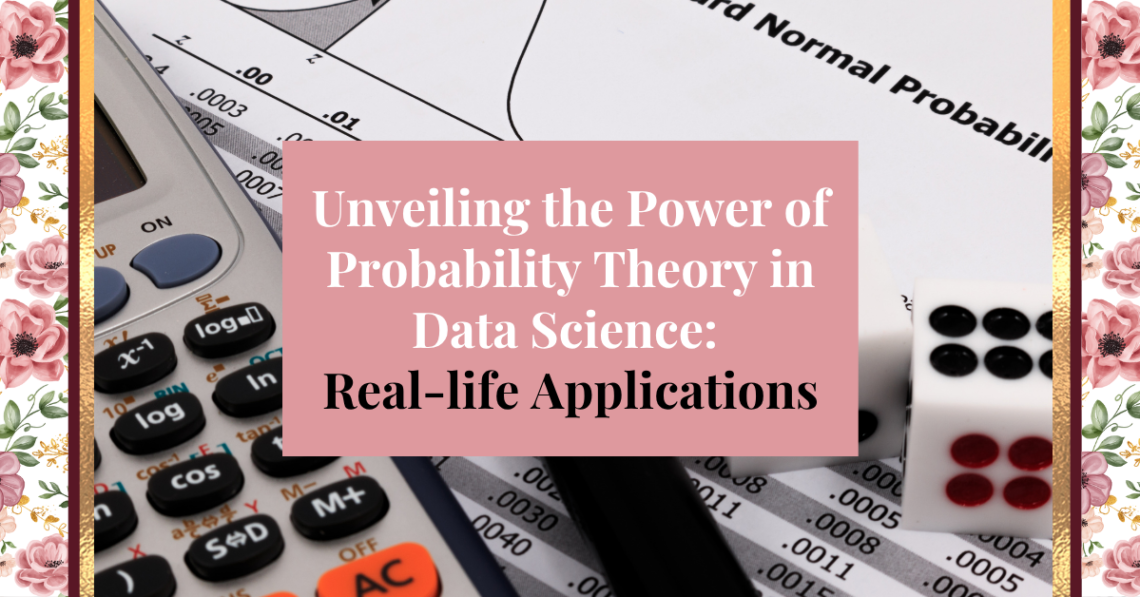Data science is transforming industries across the globe, enabling businesses, researchers, and decision-makers to gain insights from vast amounts of data. At the heart of data science lies probability theory — the branch of mathematics that deals with the likelihood of events occurring. Understanding probability is crucial for interpreting data, making predictions, and drawing conclusions based on statistical models. In this blog post, we will explore how probability theory is used in data science, with a focus on its real-life applications.
1. Risk Assessment and Decision Making
One of the primary applications of probability theory in data science is in risk assessment and decision-making. In real-life situations, decision-makers must evaluate various possible outcomes and their associated probabilities to make informed choices.
- Insurance companies use probability theory to assess risk when underwriting policies, determining premiums, and predicting future claims. By analyzing past data, they calculate the likelihood of certain events (e.g., car accidents, health issues) occurring and adjust their policies accordingly.
- Financial analysts use probability to evaluate market risks and predict stock prices, helping investors make decisions that minimize risk and maximize returns.
- In healthcare, probability models help predict patient outcomes, the likelihood of diseases, and the effectiveness of treatments, aiding doctors in making better clinical decisions.
Probability helps businesses and organizations quantify uncertainty and make decisions that balance risk and reward.
2. Predictive Modeling and Machine Learning
Probability theory plays a critical role in predictive modeling and machine learning — fields that are essential to data science. Machine learning algorithms rely heavily on probability to make predictions and identify patterns in data.
- Naive Bayes classifiers, for instance, are based on Bayesian probability and are used in text classification tasks such as spam email detection and sentiment analysis.
- Markov chains, a fundamental concept in probability, are used in reinforcement learning algorithms to model decision processes that involve sequential decisions.
- Monte Carlo simulations leverage probability to perform simulations and estimate complex systems’ behavior by running random trials.
In all of these cases, probability theory helps machine learning models handle uncertainty and improve prediction accuracy.
3. A/B Testing and Experimental Design
In data science, A/B testing is a common method used to evaluate the effectiveness of different strategies or interventions. Probability theory is integral to designing experiments, analyzing results, and drawing conclusions.
- In A/B testing, companies test two or more versions of a product (e.g., a website landing page) and measure the success of each version based on metrics like conversion rate or user engagement. Probability helps determine the statistical significance of the results and whether any observed differences are due to chance or are likely to be meaningful.
- Hypothesis testing, a key concept in probability, helps data scientists assess the validity of their findings, determining if the data supports the hypothesis that one version is superior to another.
A/B testing allows businesses to make data-driven decisions that optimize products, services, and customer experiences.
4. Fraud Detection and Anomaly Detection
Probability theory is essential in fraud detection and anomaly detection, where the goal is to identify unusual behavior or transactions that deviate from expected patterns.
- Credit card companies use probability models to detect fraudulent transactions by analyzing historical data and calculating the likelihood that a given transaction is fraudulent. If the probability exceeds a certain threshold, the transaction is flagged for review.
- Banking systems employ probability-based models to identify money laundering activities by analyzing transaction patterns and flagging suspicious behavior.
- In cybersecurity, probability models help identify unusual activity on networks, such as data breaches or unauthorized access attempts, by comparing real-time data to known patterns of normal behavior.
By applying probability theory to large datasets, organizations can catch fraudulent activity or anomalies that may otherwise go unnoticed.
5. Natural Language Processing (NLP)
In the field of natural language processing (NLP), probability theory is used to help computers understand, interpret, and generate human language.
- Language models like GPT (the model you’re interacting with) rely on probability to predict the next word or phrase in a sequence based on the likelihood of certain combinations of words occurring together.
- Speech recognition systems use probability theory to convert spoken words into text by calculating the likelihood of specific sounds or words based on contextual clues.
- Machine translation systems use probability models to predict the most likely translation of a sentence based on the structure and context of both languages.
In NLP, probability theory enables machines to process language more effectively, allowing for applications like virtual assistants, translation services, and content generation.
6. Bayesian Inference: Updating Beliefs with Data
Bayesian inference is a powerful method that uses probability to update beliefs or hypotheses based on new data. This approach is widely used in data science to continuously refine models and predictions.
- Bayesian networks represent probabilistic relationships among variables, making it easier to model complex systems and update predictions as new data becomes available.
- In medical diagnostics, Bayesian inference helps doctors update their beliefs about a patient’s condition as new test results or symptoms emerge.
- Predictive maintenance in manufacturing uses Bayesian methods to forecast equipment failures, allowing companies to take preventive action based on the probability of breakdowns.
Bayesian inference provides a flexible framework for incorporating uncertainty and improving decision-making in dynamic environments.
Final Thoughts
Probability theory is a cornerstone of data science, enabling professionals to analyze data, make predictions, and solve real-world problems across industries. From risk assessment and machine learning to A/B testing and fraud detection, probability provides the tools needed to navigate uncertainty and gain insights from complex datasets. By understanding and applying probability, data scientists can unlock the full potential of data and drive informed, data-driven decisions.
Are you using probability theory in your data science projects? Share your experiences and insights in the comments!





